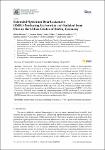Extended-Spectrum Beta-Lactamase (ESBL)-Producing Escherichia coli Isolated from Flies in the Urban Center of Berlin, Germany
Wetzker, Wibke
Pfeifer, Yvonne
Wolke, Solvy
Haselbeck, Andrea
Leistner, Rasmus
Kola, Axel
Gastmeier, Petra
Salm, Florian
Background: The monitoring of antimicrobial resistance (AMR) in microorganisms that circulate in the environment is an important topic of scientific research and contributes to the development of action plans to combat the spread of multidrug-resistant (MDR) bacteria. As a synanthropic vector for multiple pathogens and a reservoir for AMR, flies can be used for surveillance. Methods: We collected 163 flies in the inner city of Berlin and examined them for extended-spectrum β-lactamase (ESBL)-producing Escherichia coli genotypically and phenotypically. Results: The prevalence of ESBL-producing E. coli in flies was 12.9%. Almost half (47.6%) of the ESBL-positive samples showed a co-resistance to ciprofloxacin. Resistance to carbapenems or colistin was not detected. The predominant ESBL-type was CTX-M-1, which is associated with wildlife, livestock, and companion animals as a potential major source of transmission of MDR E. coli to flies. Conclusions: This field study confirms the permanent presence of ESBL-producing E. coli in an urban fly population. For continuous monitoring of environmental contamination with multidrug-resistant (MDR) bacteria, flies can be used as indicators without much effort.
Dateien zu dieser Publikation

